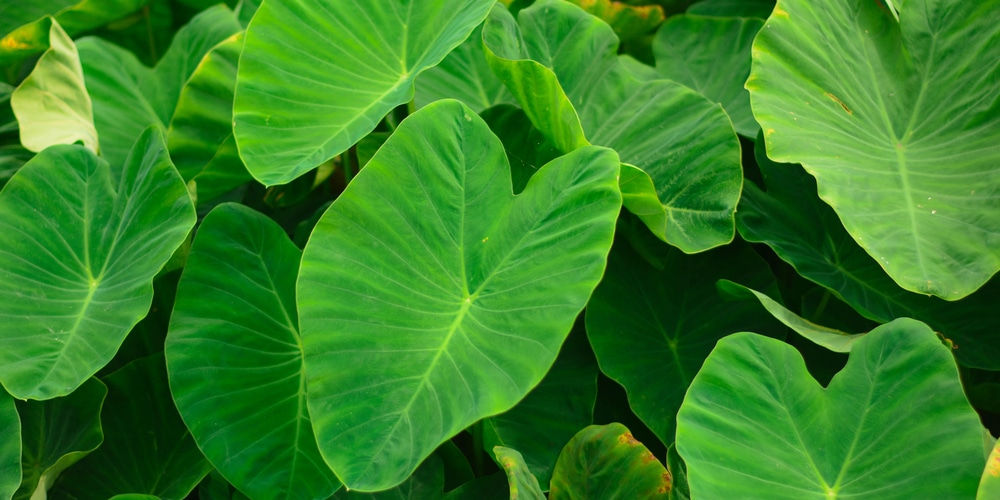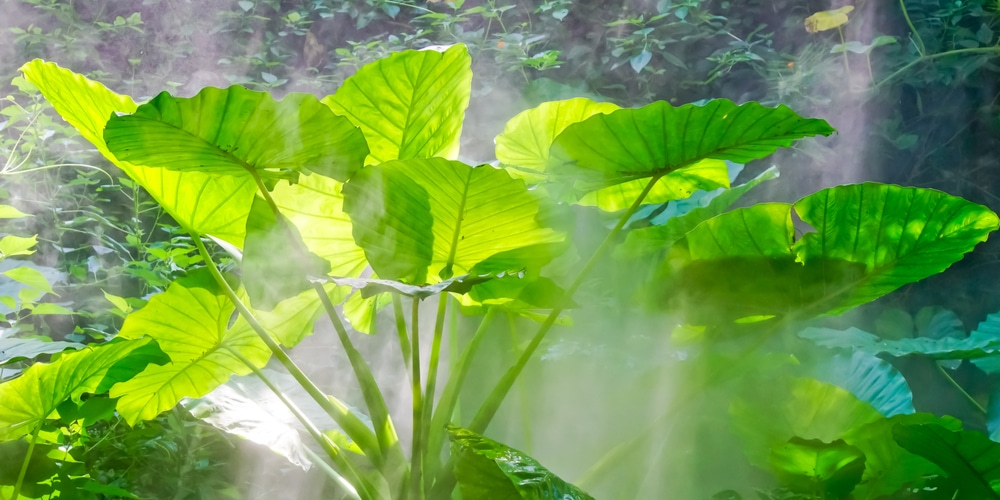According to the latest estimates made by today’s biologists, there are over 390,000 living plant species across the globe. Many of these plants are known for their unique origins, shapes, sizes, characteristics, and the benefits that they add to the environments around them. And, many of these species of plants have their own fascinating qualities that make them especially unique. One of the most notable is the beautifully exotic Alocasia Taro plant. Let’s look at how to grow and care for an Alocasia Taro plant.
What is a Alocasia Taro plant?

The Alocasia Tara plant is also known by several other names such as the Giant Taro and Elephant’s ears (just like the Alocasia Calidora). And, just as the name implies, this plant is often recognized by its gigantic evergreen-shaped leaves. The Giant taro or the Alocasia plant can be found in many tropical climates around the world, although it is native to regions in subtropical Asia, and the Pacific Islands. This is because these plants tend to grow and thrive well during the summer season and in humid weather.
Also, because of its fast-growing aroids, this giant plant can grow up to 12 – 15 feet tall, with a spread of 6 – 10′ wide in warmer climates. It is also important to note that the lifespan of the alocasia plant can range from 1 to 2 years if it’s grown in an apartment setting. Or, if this species of plant is grown and cared for in a greenhouse (under optimal conditions), this plant can live up to 15 years.
How to care for an Alocasia Taro?
Now that you have become familiar with the basics of the Alocasia Tara Plant’s growth and lifespan, it’s time to discuss a little bit more about the ultimate environment and needs of this tropical plant.
What is the Expected Temperature and Humidity for Full Growth Potential
Because the Alocasia taro is a tropical plant, they normally thrive well in climates that simulate their native habitat. Therefore, if you are looking for this plant in any place around the globe, you will most likely find the largest exotic elephant ears in areas that have the highest levels of humidity. This is primarily because these plants need a constant source of moisture to grow to their full potential. Also, because this plant does not thrive well in cooler temperatures, you need to know which warmer temperatures are best. Here’s what you should expect.
In the daytime, the temperatures should range from about 70 F to 85 F,
At night, the temperatures should not go below 60 F.
How much Sunlight is Required for Optimum Growth
As referenced above, the alocasia taro/elephant ear plant grows to its optimum size in tropical areas. So, you can expect these tropical areas to be filled with lots of sunlight, too. Yet, this plant grows differently when the sunlight is limited. For example, if you want your elephant ear leaves to grow a darker shade of green, you may want to place these plants in a setting that is a mixture of full sun to part shade. Whatever the choice or preference, the elephant ears plants are ideal for people who live in mostly sunny climates.
What are the Watering and Fertilizer Requirements
The elephant ear plants must have a consistent source of moisture in order for them to grow properly. Therefore, they will not grow in any environment where the soil dries. For instance, if they are growing in the soil on the outside, they can easily survive in an area that has at least 6 inches of standing water.
On the other hand, if elephant ear / Alocasia tara plants are placed in a container to grow, they usually need to be watered daily or several times in one day. The number of times usually varies based on the climate that they will be growing in, particularly when the soil begins to lose its moisture.
In addition to watering the Alocasia Taro plant properly, to keep these beautiful exotic plants growing to their full potential, you need to use the right type of fertilizer. And, because the elephant ears are known to be in the group of heavy feeders, the best type of fertilizer to use is a water-soluble high nitrogen fertilizer. The best schedule to follow for this application is every 2 to 3 weeks.
How to Prune Your Elephant Ears Plants / Alocasia Tara
Pruning these plants properly is essential for a number of different reasons, including making it productive for new leaves to grow. Also, as the older leaves die out, they need to be pruned to keep the plant looking healthy and vibrant.
Pruning is also a necessary part of keeping these plants safe in the winter season. This is especially true for anyone who grows these plants in zone 8 (i.e. mild winters and long hot summers). For instance, if people want these plants to survive after the winter season, they need to prune these plants before frost conditions set in. It is also important to note that there are specific pruning guidelines that they need to follow.
What’s Involved in Propagating
After you have learned how to keep these giant plants healthy and vibrant, you should learn as much as you can about propagating the alocasia taro plant. Simply put, it is time to learn how to increase the number of alocasia tara / elephant ear plants in your collection. And, the best and most effective way to go about his process is by division. The process of division has many great benefits, including helping to prevent overcrowding in one specific area and refreshing the plant’s growth.
Propagating starts at the end of the fall, which is the end of its growing season. It is also important to note that there is more than one way to go about it. For instance, you may want to collect seeds from the original plants and then replant them in the ground, you may choose to do so. However, before you start this process, you need to know that it is one of the most time-consuming and difficult to do.
